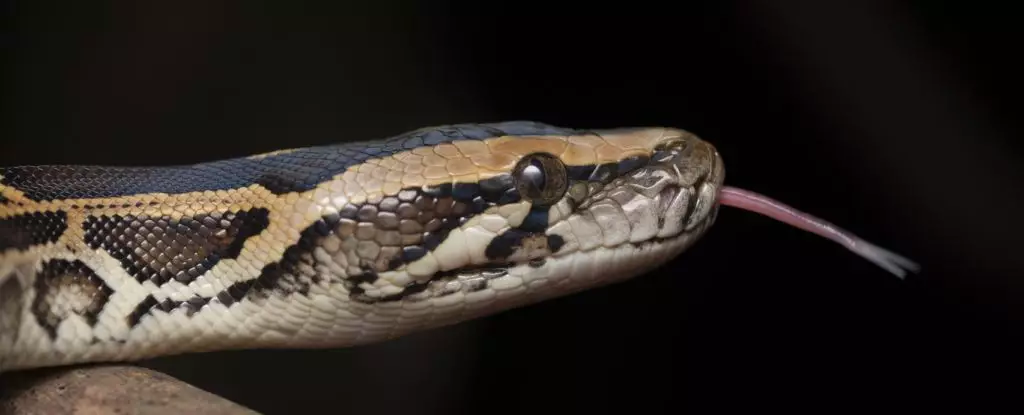The animal kingdom never ceases to surprise us with its astonishing adaptations, yet even the most extraordinary biological feats often conceal unsettling flaws. The snake’s ability to swallow whole prey, bones and all, has long been celebrated as a marvel of evolutionary engineering. But beneath this impressive facade lies a troubling question: how truly efficient is this process? A recent discovery of a new cell type in Burmese pythons challenges the romanticized view of snake digestion, revealing a hidden vulnerability — one that hints at an uncomfortable fragility in what once seemed like a perfect biological system.
This discovery sheds light not only on the snake’s unique physiology but also underscores a broader truth: nature’s solutions are often more patchwork than perfection. The identification of specialized intestinal cells geared toward handling large amounts of skeletal material forces us to rethink notions of evolutionary efficiency and resilience. If a creature that appears so perfectly adapted to its carnivorous lifestyle is still grappling with excess calcium and phosphorus overload, perhaps our own assumptions about evolutionary progress need re-evaluation.
The Illusion of Biological Mastery
For centuries, the narrative surrounding predatory animals has been one of mastery—creatures perfectly designed to conquer their environment. Snakes, with their unhinging jaws and seemingly effortless consumption of entire prey, embody this myth. Yet, the recent scientific findings reveal a stark contradiction: their bodies have developed elaborate, specialized cells precisely to deal with a problem that, in theory, shouldn’t exist. If snakes can ingest bones whole, yet their systems are so vulnerable that they require complex cellular mechanisms to prevent toxic calcium overload, what does that say about the supposed perfection of their digestive design?
This internal discrepancy hints at the reality that evolution often produces systems that are merely good enough, rather than flawless. The newly identified cells—narrow, microvilli-lined, crypt-bearing—serve as a biological safety valve, sequestering excess minerals that would otherwise swamp their physiology. This isn’t an example of optimal design but rather a compromise—a patchwork solution to a complicated problem. It invites a degree of skepticism about how much we can admire these animals’ adaptations without considering their underlying vulnerabilities.
Implications for Conservation and Animal Welfare
From a practical standpoint, this discovery should spark critical reflections on how we manage and care for captive snakes. The fact that boneless-fed snakes develop calcium deficiencies underscores how dependent these creatures are on their natural dietary components. Pet owners and zookeepers often underestimate these needs, assuming that it’s enough to feed prey devoid of bones, thereby disrupting the delicate balance that these snakes depend upon. Such negligence can lead to health problems that might go unnoticed until they result in severe physiological issues.
Moreover, this revelation carries environmental and conservation implications. As we consider the evolutionary pressures faced by wild predator populations, it becomes evident that their survival hinges on an intricate interplay of biological systems that are far more fragile than their predatory efficiency suggests. If even highly specialized animals like snakes require complex cellular machinery to digest their prey fully, we must recognize that disrupting their natural food webs—through habitat loss or pollution—could have unforeseen physiological repercussions that threaten their survival.
Reevaluating Nature’s Narrative
While the zoological fascination with snakes has long emphasized their supposed perfection, this new discovery challenges that narrative, urging us to adopt a more critical stance. Evolution shapes organisms from the ground up, often cobbling together systems that function, but not flawlessly. The existence of these specialized cells demonstrates a biological patchwork, not a pristine masterpiece. It reminds us that nature’s ingenuity is often driven by necessity—by the urgent need to cope with problems that arise from its own evolutionary pursuits.
In the broader scope, this insight compels us to view animal adaptations with a more nuanced perspective. It is a stark reminder that even creatures admired as pinnacle predators are built on a fragile foundation, with cellular defenses that could be overwhelmed under slightly changed circumstances. Recognizing these vulnerabilities doesn’t diminish the wonder of biological diversity; it deepens our understanding of it, highlighting the importance of preserving the complex, often imperfect, systems that sustain life on this planet.


Leave a Reply